Last-Minute NYC Holiday Gift Guide 🎁
We’ve created a holiday gift guide with presents for the intrepid New Yorker that should arrive just in time—


Happy March! Several of the new public art installations this month in New York City focus on current events, like the Plastic Bag Store inspired by the new plastic bag ban, or a replica of the Oval Office that’s on view at the New-York Historical Society, and an art show in an abandoned Irish pub in Lower Manhattan. Storied New York City institutions also have new exhibitions and installations, with Gracie Mansion’s latest show and giant books for the beloved New York Public Library lions to enjoy.
Check out what new public art installations you can find in New York this month!
Yesterday, the plastic bag ban took effect in New York state. Enforcement won’t begin until April and grocery stores were still giving out plastic bags yesterday. Starting March 18th, you can visit “The Plastic Bag Store” at 20 Times Square, a public art installation and immersive theater project by artist and director Robin Frohardt and produced by Pomegranate Arts.
The store, which is part of the programming of Times Square Arts will have thousands of hand-sculpted “products” made from discarded, single-use plastics. You’ll find everything you can find in a grocery store, like meat, produce, cakes, toiletries, dry goods, and even sushi rolls. In the evenings, there will be immersive performances in The Plastic Bag Store. According to Frohardt, “”The Plastic Bag Store is a visually rich, tactile, and humorous experience that hopefully encourages a different way of thinking about the foreverness of plastic, the permanence of the disposable, and that there is no ‘away’ when we throw something out. It is my attempt to make something authentic and human from that which is mass-produced. There is great humor to be found in the pitfalls of capitalism, and I find that humor and satire can be powerful tools for social criticism especially with issues that feel too sad and overwhelming to confront directly.”
ARTECHOUSE has been a smash hit with our Untapped New York Insiders and its newest immersive installation, “Intangible Forms” opens on March 3rd It’s an audio visual journey into both the known and unknown by Japanese multi-media artist Shohei Fujimoto. This multi-sensory installation highlights the connection between living beings and inanimate objects through patterns created by the rhythms found in repetitiveness and modularity of the world around us.
The results are dramatic, visceral, almost operatic in nature, inviting guests to exist in a space and time all its own, for the duration of the visit. We’ll be offering our Untapped New York Insiders tickets to Intangible Forms (info coming soon!), but if you can also book your tickets here!
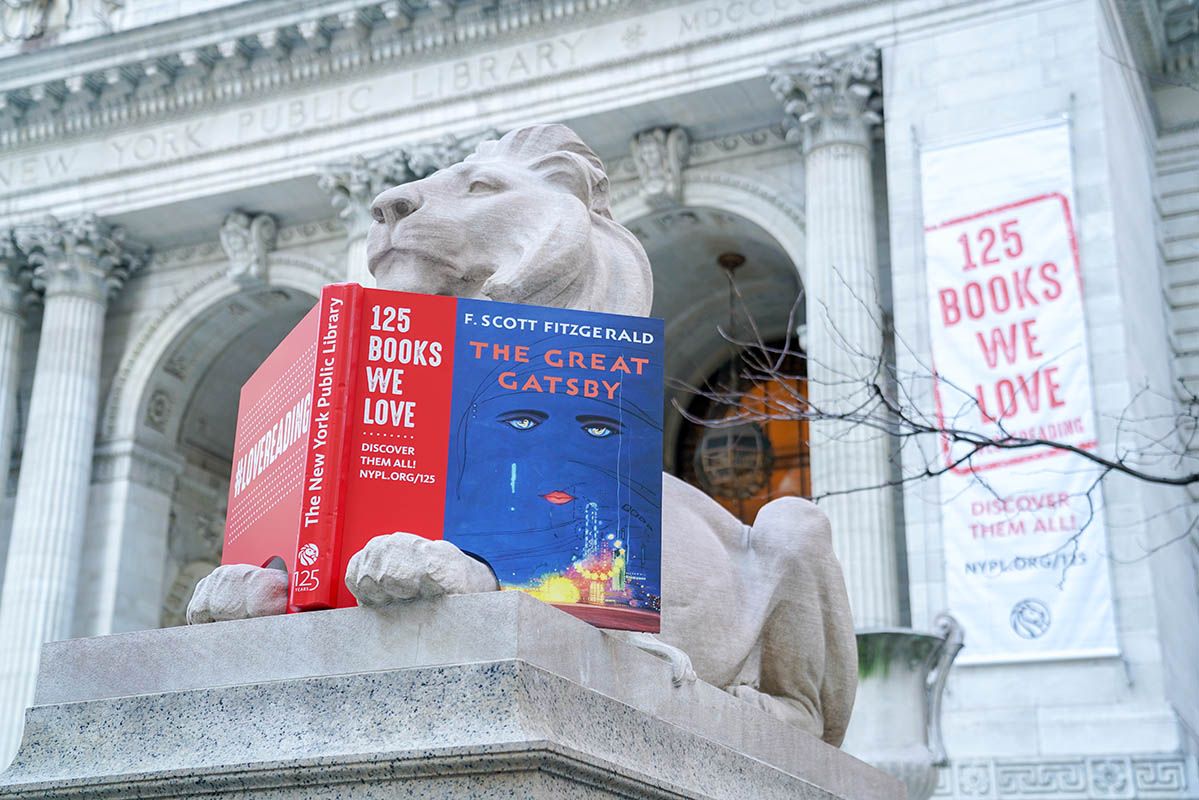
Photo by Jonathan Blanc / NYPL.
In celebration of the New York Public Library’s 125th Anniversary this year, the two lions along the library’s main branch on 5th Avenue were provided with large, “lion-sized” copies of two books that were released on the Library’s 125 Books We Love list: Beloved by Toni Morrison and The Great Gatsby by F. Scott Fitzgerald. We are told by the NYPL that the books will be changed throughout the year.
The 125 Books We Love list, which was chosen by librarians, also includes favorites like The Amazing Adventures of Kavalier & Clay, Gotham: A History of New York to 1898, Atonement, 1984, The Bonfire of the Vanities, Brooklyn, Brideshead Revisited, Catch-22, the Catcher in the Rye, Devil in the White City, the English Patient, A Game of Thrones, and over 100 more.

Photo courtesy Airbnb
This month along the New Jersey shore, you can stay overnight in Lucy the Elephant, a historic giant elephant that has been decked out by Airbnb. It is a cousin to the famous Coney Island “Elephant Colossus,” a 200-foot tall elephant structure with 31 rooms that once stood proudly and prominently on Surf Avenue.
Lucy’s current caretaker is Richard Helfant, director of the non-profit Save Lucy Committee, proclaimed to the New York Times that Lucy is “the oldest surviving example of zoomorphic architecture on Earth” and she has been designated a national landmark. Inside, it’s a Victorian-era paradise and you can join other famous prior guests like Henry Ford, President Woodrow Wilson and the Sultan of Brunei for just $138 a night. It’s a short-term proposition, as only three dates will be available on March 17, 18 and 19. Bookings will begin on March 5. Airbnb will be making a donation to the Save Lucy Committee.

Photo courtesy FiDi Arsenale/Hot Air.
Just blocks from the World Trade Center, the abandoned Irish pub Barcleycorn has been reactivated as the art exhibition FiDi Arsenale opens. FiDi Arsenale features 16 emerging artists and architects, and is curated by Hot Air and Collin Clarke from the Brooklyn gallery Mery Gates.
Hot Air is led by designer Bika Rebek and Matt Shaw and is focused on providing an alternative platform for artists in New York City. Rebek, who is also an Adjunct Professor at Columbia University GSAPP and the principal of Some Place studio, tells Untapped New York, “We don’t have a permanent gallery space. We’re always occupying empty or abandoned or in-between spaces. Now we found this abandoned Irish pub.”
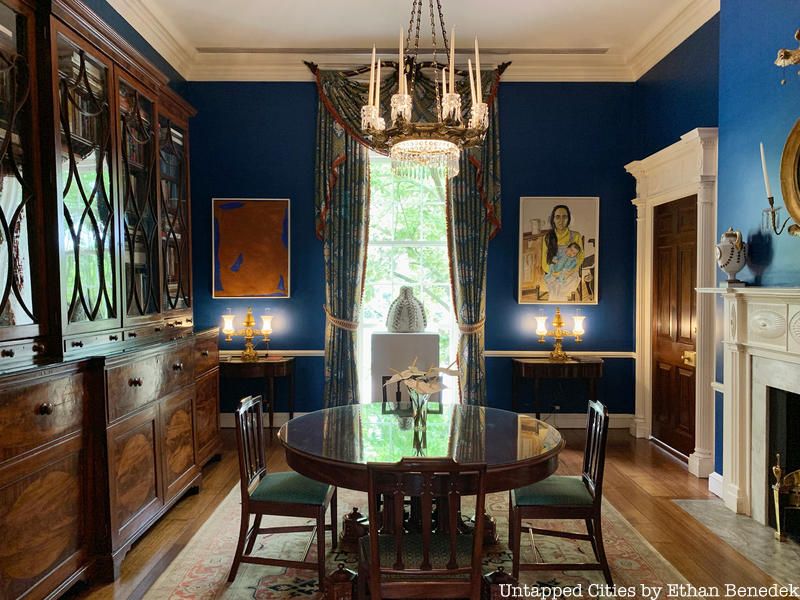
The latest exhibition at Gracie Mansion, Catalyst: Art and Social Justice, is curated by New York City’s first lady, Chirlane McCray. The exhibition showcases New York artists, activists and activist movements since 1965, “celebrating the power of art to spark change and spur progress.” McCray tells the New York Times that when she and Mayor Bill de Blasio first moved into Gracie Mansion, they were struck by the all the portraits hanging inside. She said to the Times she wondered, “‘Where are we? How do we fit in here? Where are the people we know? Where are the people of our city and what do we need to do to really be the people’s house?’”
With over 80 works and more than 50 artists represented, you’ll find a diverse range of medium in Catalyst: Art and Social Justice from photography to abstract painting to graphic art to portraits and sculpture. There is a piece by Devra Freelander, the artist killed by a cement truck last summer while biking in Brooklyn, that shows an iPhone that was frozen in ice and encased in acrylic. There are photographs by Gordon Parks, who documented both the plight and successes of African Americans in the mid to late 20th century, as well as newer images of New Yorkers by Martine Fougeron and Naima Green.
Join us on March 11th and April 1st at 11:30 AM for two special behind-the-scenes tours of Gracie Mansion for Untapped New York Insiders where you can see this exhibition. If you aren’t a member yet, join us today!
BECOME AN INSIDER!

From the late 1980s to early 2000s, Rainbow Shoe Repair, a shoe cobbler was located at 170 Delancey Street on the Lower East Side. As a side hustle on top of fixing shoes, the staff at Rainbow became well-known for taking affordable passport photos and portraits for neighborhood locals. Rainbow Shoe Repair was Lower East Side staple in a pre-Instagram world, where local residents stopped by for a casual shot of a fly outfit, or to document important milestones like communions, graduations, and everything in between. It became a destination for people in the neighborhood to express something about themselves or their families and friends.
Now, the exhibition “Rainbow Shoe Repair: An Unexpected Theater of Flyness” at the Abrons Art Center and in multiple locations on the Lower East Side showcases some of those portraits that were taken when the shoe shop was open. The photographs were acquired through an open call and from the Rainbow Shoe Repair archive.
On an upcoming curator-led walking tour of the Lower East Side on March 12th, Ali Rosa-Salas from the Henry Street Settlement will take Untapped New York Insiders to three locations that are part of the Rainbow Shoe Repair exhibition, and ending at the monthly ceremonial fire outdoors in the amphitheater at Abrons Arts Center that explores Indigenous protocol and knowledge. “The exhibition definitely warranted a life outside the gallery space,” Rosa-Salas tells us.
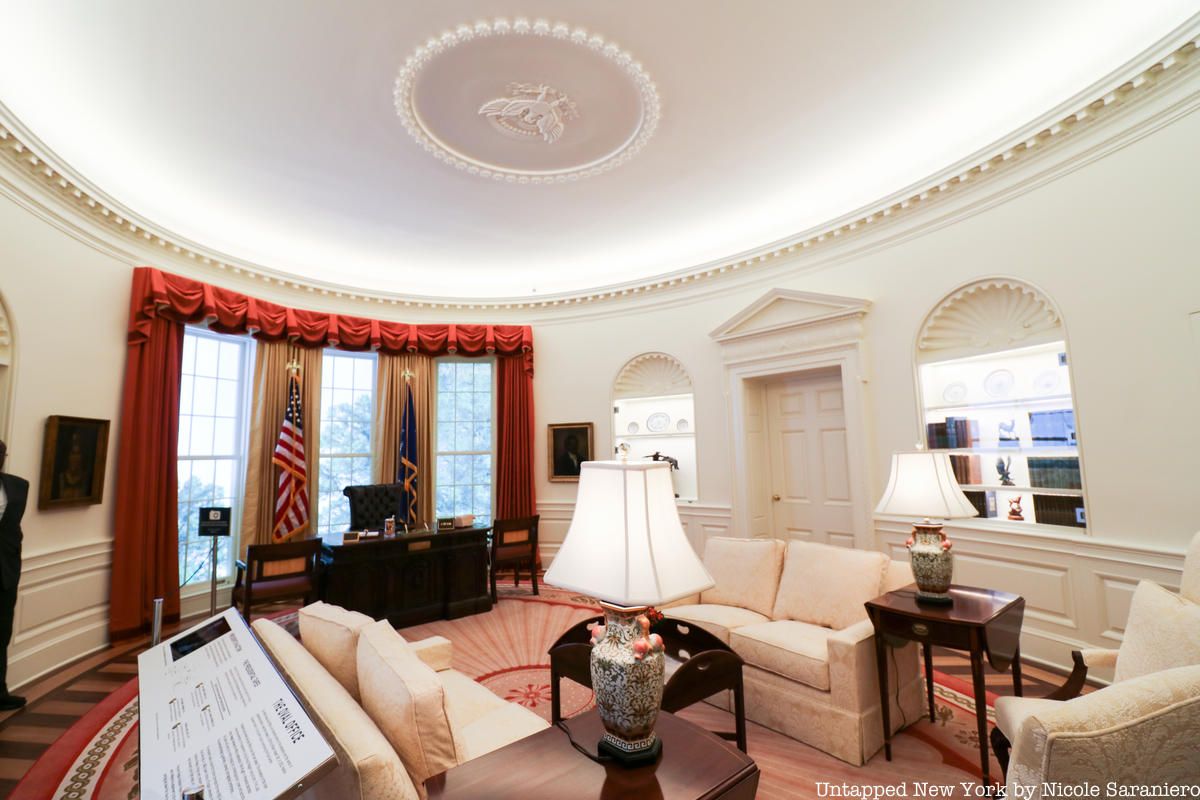
This election year, as Americans consider who to put in the Oval Office, the New-York Historical Society invites visitors to step inside a re-creation of that most famous room in the White House. Through a series of special exhibitions and events, the museum will explore the cornerstones of citizenship and American democracy throughout 2020. Starting on Presidents’ Day Weekend, visitors to the new Meet the Presidents exhibition will discover how the role and powers of the president have evolved since George Washington, and find out what the view looks like from behind the president’s desk.
The new exhibition will be a permanent fixture of the museum’s fourth floor galleries. Serving as the centerpiece, a detailed re-creation of the White House Oval Office will give visitors the opportunity to sit, and take a photo, in a replica of the room where presidents have exercised their powers, duties, and responsibilities since 1909. Each president has slightly altered the room to fit his own tastes, but the version represented at the New-York Historical Society reflects the most widely considered classic interpretation. The room appears how it would have during the second term of President Ronald Regan.

Photo from NYC Parks courtesy Manuel Ferreiro Badia
A stainless steel sculpture by Spanish artist Manuel Ferreiro Badia is now on display at Finn Park in Tribeca. The work, entitled Compostela Fractal Study of a Shell is, according to NYC Parks, “based on origami studies and is composed of broken steel planes that cause the sculpture to change or live with sunlight. It reflects in an abstract way the fractal system of matter, looking for a simplicity that reflects the interior of every being. It is a work inspired in the study of the nature, in particular of a shell: the volume is reduced to its fractal structure, to its geometry.”

Photo: Ka-Man Tse for Times Square Alliance
Every month a new video installation takes over the screens of Times Square at midnight for Midnight Moment, the world’s longest running digital art exhibition. This month from 11:57 PM to midnight, the screens will be taken over by Jeffrey Gibson, an artist of Choctaw and Cherokee descent in “She Never Dances Alone.”
The work combines elements of traditional Native American craft with the visual languages of modernism to draw powerful personal, cultural, and historical connections between the two. Gibson’s work across painting, sculpture, and installation is invariably vibrant and visually rich. He is known for using traditional Indigenous materials, including animal hides, glass beads, and tipi poles, alongside more contemporary mediums such as video, paint and ceramics to create wearable sculptural garments, stand-alone sculptures, mixed media paintings and immersive installations.
A special viewing will take place March 7th with a free, public performance by Sarah Ortegon leading into the Midnight Moment. This month’s Midnight Moment is presented by Times Square Arts, The Armory Show, Brooklyn Museum, Kavi Gupta, and Roberts Projects.
Keep reading to check out installation still on view from previous months!
 The Family. Beach Channel High School, 1974. 100-00 Beach Channel Drive, Queens, NY. Photo by Lea Bertucci. Courtesy of The Irwin S. Chanin School of Architecture Archive, The Cooper Union.
The Family. Beach Channel High School, 1974. 100-00 Beach Channel Drive, Queens, NY. Photo by Lea Bertucci. Courtesy of The Irwin S. Chanin School of Architecture Archive, The Cooper Union.
You may not know the name of Italian sculptor Costantino Nivola off the top of your head, but New York City is home to the largest collection of his sculpture in the world. He was responsible for 21 commissions here, often in public buildings like schools and police stations, of which 17 still exist in places like William E. Grady High School on Coney Island and Beach Channel High School in Queens. Now, a new exhibition, Nivola in New York: Figure in Field, at the Arthur A. Houghton Jr. Gallery at The Cooper Union has just opened that highlights his New York City works.
The exhibition focuses on four of his New York City works: Nivola’s first New York City commission — a 76-foot long wall relief in the Olivetti showroom, the “Apple store of its time,” a 1953 sandcast basrelief cartouche on the south façade of Coney Island’s William E. Grady High School, a collection of sculptures and bas relief works in the Stephen Wise Recreation Area on the Upper West Side, and bronze statuettes and plaques on the 19th Precinct Combined Police and Fire Facilities on the Upper East Side.
We will be hosting a free walking tour of Nivola’s works in conjunction with the exhibition on March 9th. The exhibition will be up until March 15, 2020.
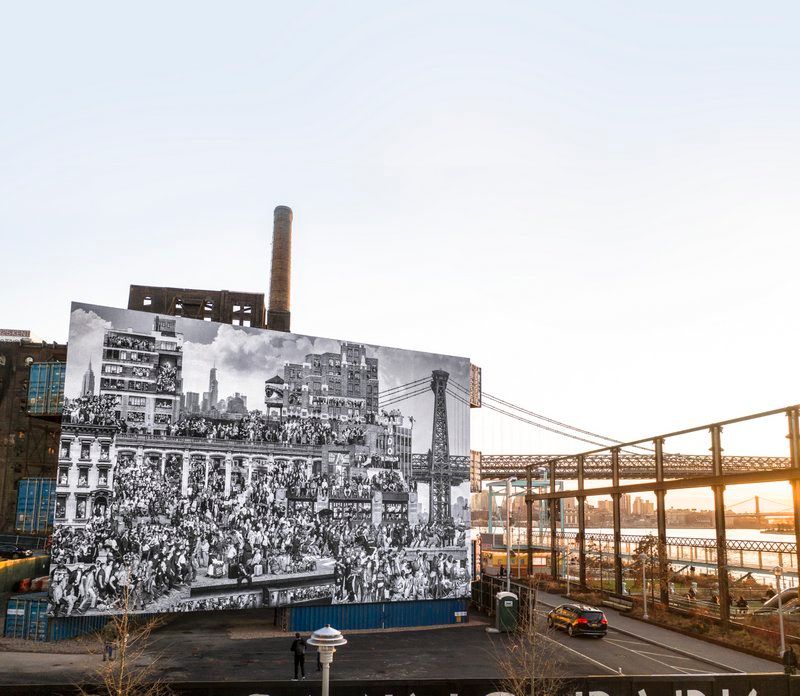 The Chronicles of New York City, JR and Triangle Stack 2, LOT-EK at Domino Park. Photos by Marc Azoulay ©JR-ART.net
The Chronicles of New York City, JR and Triangle Stack 2, LOT-EK at Domino Park. Photos by Marc Azoulay ©JR-ART.net
You may have noticed something big going up in Domino Park in Williamsburg recently. Atop a set of stacked shipping containers, in an installation designed by the firm LOT-EK, the artist JR is putting up his latest large-scale wheat paste work, Chronicles of New York. The installation, is produced in conjunction with the Brooklyn Museum’s current exhibition JR: Chronicles, and is a compilation of over 1,000 New Yorkers the artist has photographed, including Untapped New York’s photography instructor, Stephanie de Rouge, who ran our One Place, One Face workshops.
The work, which opens officially Monday February 3 is presented by the Brooklyn Museum with additional support from Two Trees Management and Domino Park. LOT-EK is known for its sustainable, adaptive reuse of materials like shipping containers.
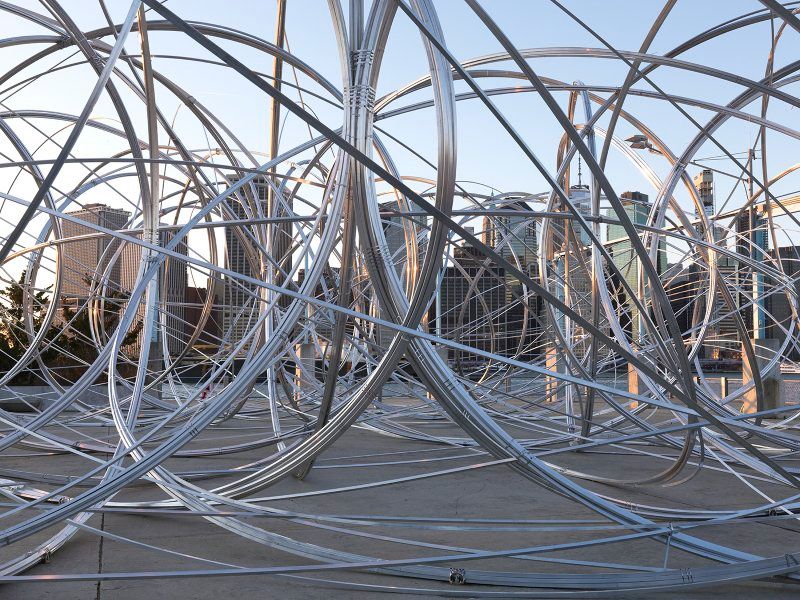
Antony Gormley, NEW YORK CLEARING, 2020. Installation view, Brooklyn Bridge Park, Pier 3, New York City, 2020 Photograph by Christopher Burke
On Tuesday, February 4th in Brooklyn Bridge Park, British artist Antony Gormley will be unveiling a work consisting of more than 11 miles of square aluminum tubing in loops and coils that will rise to almost fifty feet against the backdrop of the East River and Lower Manhattan. Entitled New York Clearing, the press release describes it as “an environment for the viewer that counters the grid of modernism and the city with swooping lines of energy.”
Gormley states: “This is the first time that I have attempted to make Clearing without architectural support. I am enormously excited about the opportunity of making this energy field in conversation with Manhattan across the waters of the East River. It can be seen as an evocation of human connectivity, a materialisation of the energy of the people that view it and the people that made it.” The work will be located at Pier 3 in Brooklyn Bridge Park.
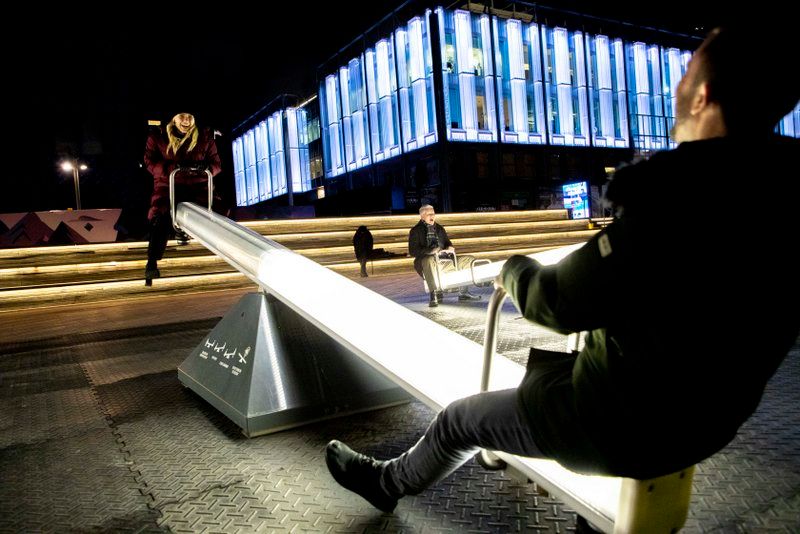
Photo courtesy Wagstaff New York
If you loved the illuminated see saws in the Garment District, incredibly there is an entirely separate new installation of a similar kind at the South Street Seaport called Wave-Field. The installation lights up and responds with sounds as people ride on the see saws, and is produced by CS Design and Lateral Office. The first installation of this kind was located on Montreal in 2016. The South Street Seaport installation, located on the plaza between Pier 17 and the Wavertree boat, will be up until the end of March.
At rest the seesaws have a humming sound, and then each see saw will emit different sounds depending on which one you sit on. “As more visitors partner up and join the conversation, the richer the artwork becomes and the more intense the physical experience is for every single participant, eventually cascading into an organic symphony that oscillates on the fine line between chaotic and coherent,” according to the organizers.

Inside the 5th Avenue-53rd Street subway station, a new site-specific exhibit showcases the connection between modern art and the graphic design of New York City’s transit system. The vinyl displays are a collaboration between MTA Arts & Design and The Museum of Modern Art, which has in its collection several objects related to the creation of the subway’s graphic design and more recent graphic innovations.
The panels in the new exhibit show an illustrated timeline of subway design, pages from the Graphic Standards Manual, and quotes from people involved in the graphic design in the subway system. The bold and recognizable icons, exploded in size for the exhibit are show-stopping and should fulfill one of the goals of the project, which according to the MTA is to “to create a museum quality exhibit that would prove interesting to riders who navigate our system each day and those who use the subway to reach the Museum.”
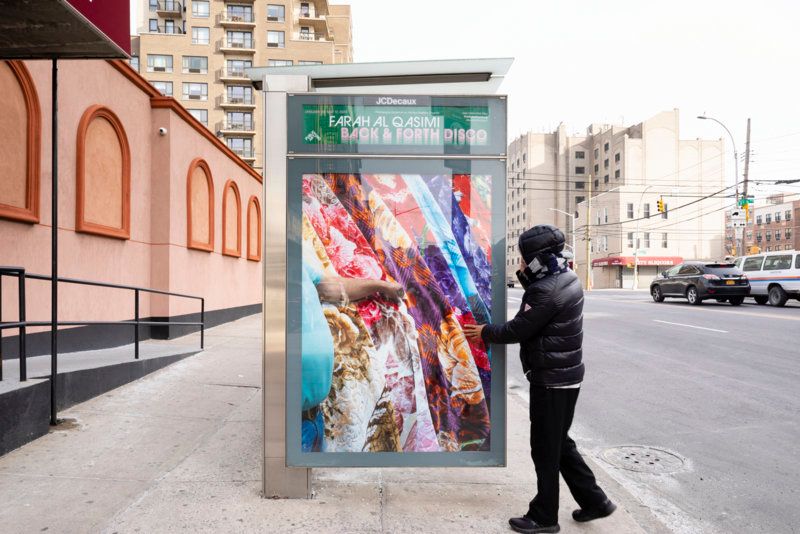 Farah Al Qasimi, Blanket Shop, 2019. Photo: James Ewing, Courtesy of Public Art Fund, NY. Photographic work as a part of Back and Forth Disco, presented by Public Art Fund on 100 JCDecaux bus shelters citywide, January 29 – May 17, 2020.
Farah Al Qasimi, Blanket Shop, 2019. Photo: James Ewing, Courtesy of Public Art Fund, NY. Photographic work as a part of Back and Forth Disco, presented by Public Art Fund on 100 JCDecaux bus shelters citywide, January 29 – May 17, 2020.
The Public Art Fund is behind a set of seventeen new works by artist Farah Al Qasimi, from Abu Dhabi in the United Emirates, featured on the JCDecaux bus shelters around the five boroughs. Born in 1991, Al Qasimi works between Brooklyn and Dubai, and in these works, she’s using New York City as a subject matter for the first time.
According to Public Art Fund, “Back and Forth Disco breaks through the chaos and anonymity of the city to explore the experience of being an individual in an overstimulating place. Farah’s known for her richly textured photographs and distinct approach to portraiture, and by utilizing elements of camouflage and concealment, she emphasizes her subjects’ individuality, challenging traditional notions of figuration.” The works show everyday New York places — a bodega, a fabric shop, a bakery, barbershop, beauty salon and more — but from her lens, selecting moments that surprise the viewer about the particular subject matter. You can find a map of all the locations here.
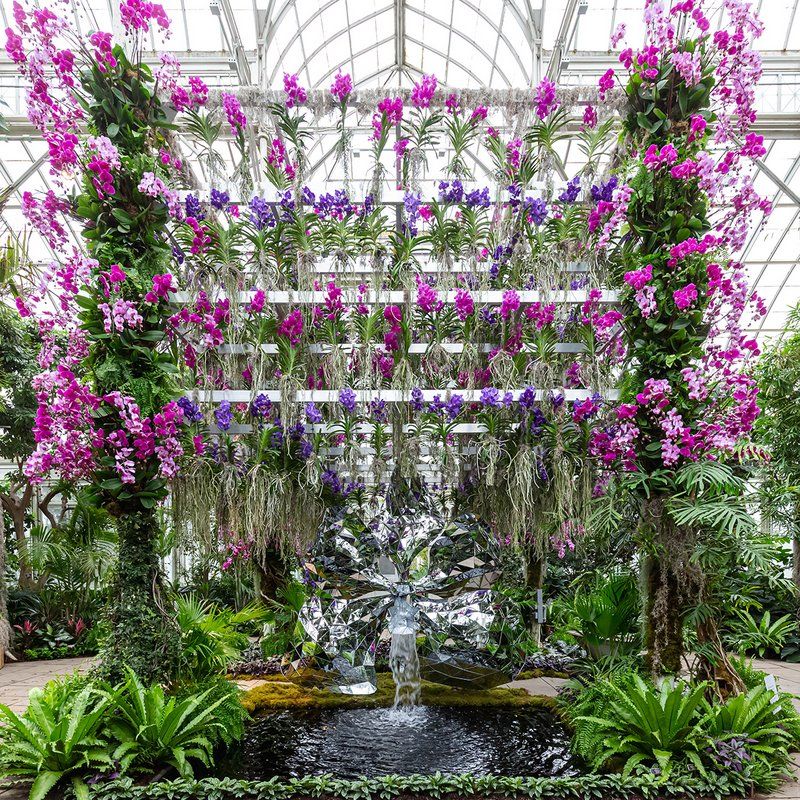 Photograph courtesy of New York Botanical Garden
Photograph courtesy of New York Botanical Garden
On February 15th, the annual New York Botanical Garden Orchid Show will open to the public for its 18th year. This year’s show is entitled “Jeff Leatham’s Kaleidoscope.” Through April 19th, thousands of orchids will be on display in designs by celebrity designer Jeff Leatham, who has also created captivating installations, like a tunnel of light.
According to the Botanical Garden, Leatham’s captivating designs and installations will transform each gallery of the exhibition in the historic Enid A. Haupt Conservatory into a different color experience, like the turn of a kaleidoscope,

Photo by Timothy Schenck. Courtesy of the High Line.
On the side of a building along the High Line, a new mural went up at the end of December by Jordan Caastel entitled The Baayfalls. This high profile location has been the site of numerous previous High Line commissions, including the most recent by Dorothy Iannone, I Lift My Lamp Beside the Golden Door. The Baayfalls is a based on a 2017 painting by Casteel, who is known for her larger-than-life canvas portraiture. She captures people she knows and also those she encounters in our daily routine around New York City, working from hundreds of photographs.
According to High Line Art, “The Baayfalls is a double portrait of Fallou—a woman Casteel befriended during her artist residency at The Studio Museum in Harlem—and Fallou’s brother, Baaye Demba Sow. The pair are pictured outside the museum at Fallou’s table, where she sold hats she designed. When Fallou’s brother arrived in New York from Senegal, Casteel asked the two to sit for a portrait. The title references Baye Fall, a sect of the Sufi brotherhood Mouride, of which Fallou’s brother is a member. The gesture Fallou makes with her left hand signifies Allah among members of Baye Fall. Casteel’s work for the High Line extends the Harlem sidewalk to the park, connecting public spaces of different neighborhoods across the city. Through her portraiture, Casteel adds deeply nuanced expressions of human experience to the expanding collection of images we see every day.” The Baayfalls will be on display until December 2020.

Krzysztof Wodiczko (American, b. Poland 1943) Monument, 2020. Photo credit: Andy Romer Photography.
Admiral Farragut fought for the Union side in the Civil War and as the Madison Square Park team explains, “Pertinent to this project is current scholarship documenting how the American Civil War drove millions – soldiers, civilians, stragglers, enslaved Africans, free people, Northerners and Southerners – from their homes to generate a nineteenth-century refugee crisis. Similarly, each filmed participant’s home country has suffered the devastation of civil war which prompted Wodiczko to choose the Farragut location for this project to compare how select individuals are lionized in wartime and others are overlooked. With footage of people from Africa, Central America, South Asia, and the Middle East, the bronze monument emerges as a surrogate for refugees whose diverse plights, harrowing journeys, grueling fortitude, and quest for democracy have recently brought them to this country.”
Monument will be on view until May 10, 2020.More than timely, Madison Square Park unveiled a site-specific work in January superimposed on the sculpture of the 1881 monument to Admiral David Glasgow Farragut inside the park. Artist Krzysztof Wodiczko, born in 1943 in Poland and an immigrant to the United States, worked with twelve refugees from all around the world who have settled in the United States, and the work projects their likeness and spoken narratives onto the Farragut monument in a 25 minutes video shown daily from 5 to 8 PM.

Image courtesy of Six Summit Gallery
Located in Dag Hammarskjold Plaza on East 47th Street, named after the United Nations Secretary-General who died in an airplane crash en route to the Congo, Ailene Fields’ Once Upon a Time and and The Frog Prince puts a whimsical twist on the public space, with a larger-than-life frog prince and a fairy located on a branch.
According to NYC Parks, Fields has been fascinated since she was a child by ancient Greek and Roman mythology: “Taking harsh materials such as bronze and stone and transforming them into gentle characters is a major goal for the artist. It is a process of finding what has been trapped within since time immemorial and allowing it to reveal itself to the world.” Once Upon a Time and and The Frog Prince will be up until April 26, 2020.

Image courtesy of Harlem Needle ArtsPhoto courtesy NYC Parks
In Charles Young Park in Harlem, a three-part public art exhibition entitled A Long Walk to Freedom and Reflection activates a small triangular park including yarn installations for the park’s lampposts and benches, along with a 100-foot long fence installation along Adam Clayton Powell Jr. Boulevard.
According to NYC Parks, “The horizontal, abstract composition is bookended by the numbers 1619 which refers to the year when American slavery began, and an infinity symbol. The artist has also created colorful yarn installations for the park’s lampposts and benches to make the space more inviting. This installation is part of Harlem Needle Arts’ larger We the People | Disrupting Silence textile series and public art initiative honoring African Diasporic peoples past and present.”
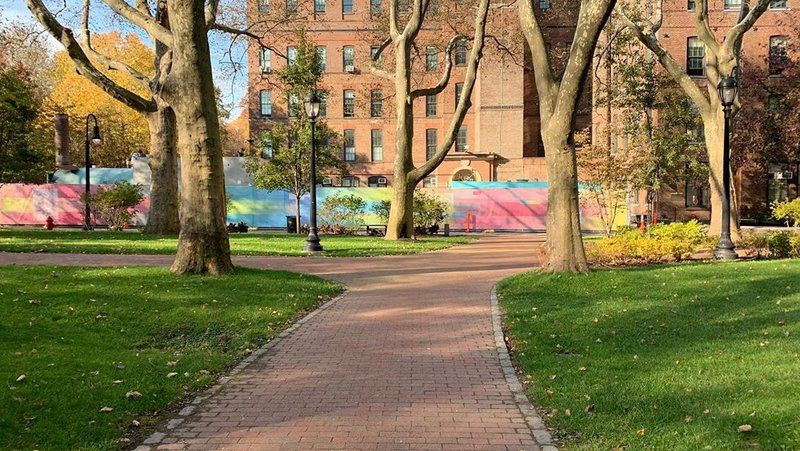 Photo courtesy Pratt Institute
Photo courtesy Pratt Institute
Pratt, known for its incredible collection of world-class public art installations, has a temporary exhibition entitled GenZ in the middle of the Brooklyn campus that showcases the work of Spring 2019 Associate Degree Program graduates 90 inches high and sometimes up to 108 feet. The exhibition was designed by AOS Graphic Design student Scott Stegman.
According to Pratt, the works in the exhibition were “inspired by the movement around the PrattBrooklyn campus and the generator itself. The design has no beginning or end. It seamlessly flows as the viewer walks around its borders while mirroring their journey back to them.” GenZ will be up until May 1, 2020.

Rendering of Anish Kapoor sculpture at 56 Leonard St. © Anish Kapoor, 2017
Internationally celebrated, Turner Prize-winning artist Anish Kapoor will have his first permanent public artwork in New York City at 56 Leonard Street. The sculpture has been a key element of the building’s design since the beginning and will be integrated into the architecture of the Tribeca tower.
Kapoor’s monumental mirror sculpture is an enigmatic balloon-like form that will sit at the base of the 60-story structure and seemingly both prop up the building and be squashed by it. The sculpture weighs 40 tons and measuring 48 feet long by 19 feet high. Kapoor’s untitled work is about halfway complete, and will hopefully be viewable this month!
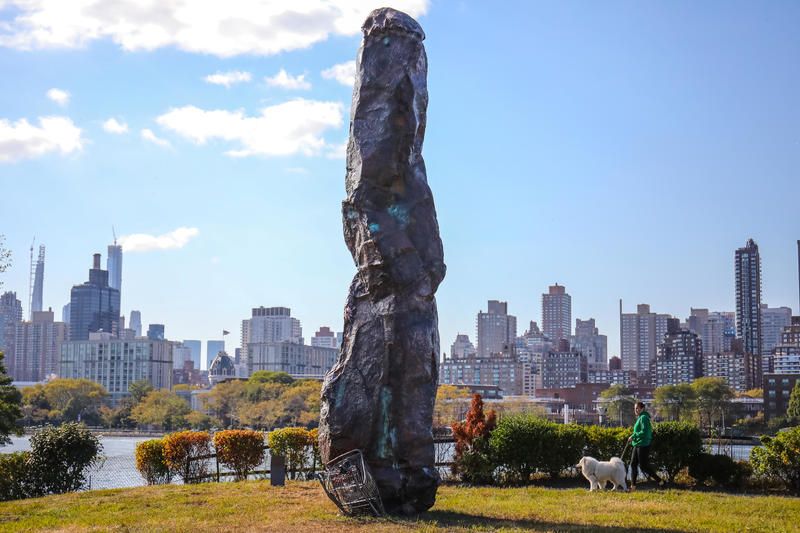
Rock n Roll, Photograph by Scott Lynch, Courtesy of Socrates Sculpture Park
Every year, a select group of artists are chosen to receive the ‘Socrates Annual’ fellowship, and have their work displayed inside the Socrates Sculpture Park. The new commissions are produced on-site in an outdoor studio over the course of the summer. The works selected engage the Park’s unique history, landscape, and the surrounding community.
For the 2019 exhibition, projects range from a soundscape of the sounds of animals and man-made objects, to a monument to the invasive Ailanthus plant. Several artist projects examine storytelling, from an homage to a Native American myth in which North America exists on a turtle’s back, to a suggestion that a giant has fallen asleep under the Park’s blanket of grass, its exposed nose becoming refuge for a wandering monitor lizard. This group of sculptures will be on display through March 8th, 2020.

A new sculpture by Brazilian artist Rubem Robierb has fluttered into Tribeca Park. The 13-foot wide fiberglass sculpture is a pair of opalescent white butterfly wings that are made for you to stand in front of. The strong yet graceful image is dedicated to the transgender lives that have been lost. The sculpture, which is part of Robierb’s “Dream Machine” series, is named after Dandara dos Santos, a trans woman who was murdered in Brazil in 2017.
Robierb hopes the sculpture, which symbolizes rebirth, will inspire those who see it to spread their wings and follow their own dreams. The sculpture is a monument to the bravery of members of the trans and gender non-conforming communities. It aims to raise awareness for the necessity of LGBTQ+ protections. The sculpture will be in Tribeca Park until May 4, 2020.
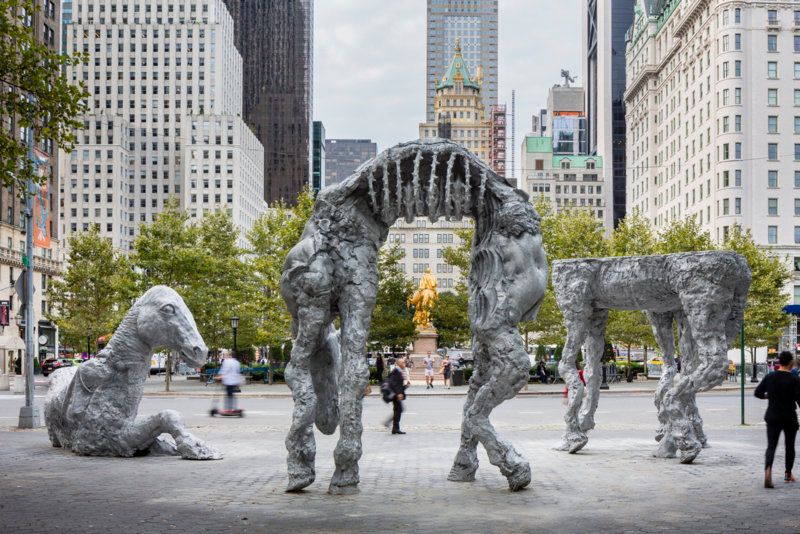
Photo: Nicholas Knight, Courtesy of Public Art Fund, NY
Public Art Fund returns with another striking installation at the entrance to Central Park. On September 11th, three whimsical aluminum equine sculptures will be on display by French artist Jean-Marie Appriou. The works, ranging in size from 16 feet tall to 16 feet long, will be inspired by the site and the history of horses here, including the gold leaf statue of William Tecumseh Sherman just across the way and the horse-drawn carriages that still ply the park and pick up at this entrance.
“Jean-Marie Appriou’s unconventional approach to sculpture is almost alchemical,” says Public Art Fund Associate Curator Daniel S. Palmer. “His craftsmanship is informed by a deep knowledge of the historical lineage of sculptors that have preceded him. At the same time, Appriou’s equine sculptures are otherworldly, evoking the silent majesty of horses with nuanced sculptural details that flicker between narrative and poetry.” The horse sculptures will be on display through August 2020.

A new poetry jukebox has popped up outside in Bella Abzug Park near Hudson Yards. Previous jukeboxes have appeared in the East Village and Greenwich Village. The poetry jukebox first appeared at the Howl! Festival 2017 where coffeehouse owners from the Czech Republic introduced the funky speaker as part of an installation. The over two dozen poems were curated by Bob Holman and BC Edwards and represent a collective response to social justice. The jukebox in Bella Azbug Park through April 2020, along with other sculptures worth a visit to see.

The latest artist to grace the Bowery Mural on Houston is Japanese artist Tomokazu Matsuyama “Matzu” who started working on the mural last week and is close to wrapping up. Matzu was born in Japan but moved to New York City in 2000 and currently lives and works in Brooklyn. He will be doing a high profile installation for the 2020 Summer Olympics in Japan, building a 24-foot tall sculpture at JR Shinjuku Station consisting of 316 pieces of stainless steel.
When asked how he felt about getting the opportunity to paint the mural, Matzu told Untapped Cities that this will be his biggest mural and that “it is something great because, as every artist knows, this wall is a significant monument for the world. It almost feels like you are contributing to the New York Arts culture in general. Without SoHo you can’t really talk about the arts in New York and arts in the world in general.”
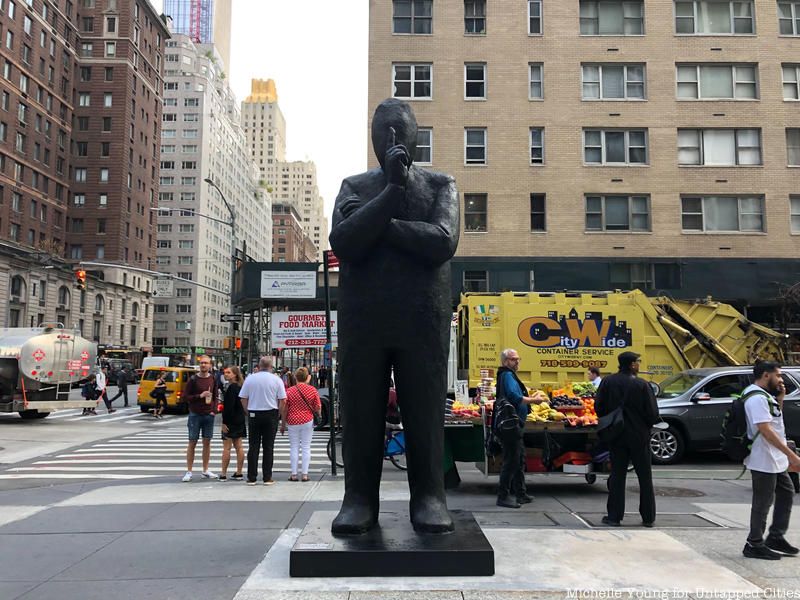
Where Robert Indiana’s LOVE sculpture was in Midtown until earlier July has been replaced by a temporary sculpture of a man in business suit shushing passerby until LOVE is fully restored.
The sculpture by Jim Rennert, who has similar work previously in Union Square, is twelve feet tall. It’s on display thanks to the Cavelier Gallery, located on 57th Street.

The gender balance between male and female statues in New York City is little more even now thanks to a large scale sculpture installation. Created by the husband-and-wife team of the award-winning public artists Gillie and Marc, Statues for Equality aims to remedy the fact that less than 3% of statues in New York City are dedicated to females by creating ten larger than life-sized bronze sculptures of famous women from astronaut Tracy Dyson to actress Nicole Kidman. The new statues honor the important contributions women have made to society and they make their debut today, on Women’s Equality Day 2019.
Recently moved from Sixth Avenue to 32 Old Slip in Lower Manhattan, you will find bronze representations of Oprah Winfrey, P!nk, Nicole Kidman, Jane Goodall, Cate Blanchett, Tererai Trent, Janet Mock, Tracy Dyson, Cheryl Strayed and Gabby Douglas. The subjects of the statues were chosen by a public vote. Each woman is standing atop a blooming flower of her choosing which represents her personality, beyond her technical and social accomplishments. With the addition of these ten figures, the percentage of female statues in the city rises to 9%. The statues will be on display until August 2020.
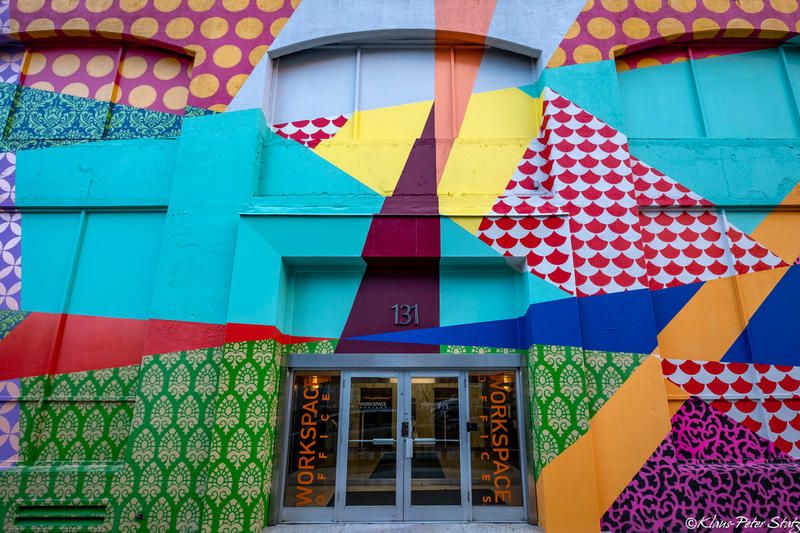 Photograph taken by Untapped New York Insider Klaus-Peter Statz on our tour with Hudson Square BID
Photograph taken by Untapped New York Insider Klaus-Peter Statz on our tour with Hudson Square BID
Hudson Square Business Improvement District (BID) has launched a new public art initiative, Hudson Square Canvas, to reflect the neighborhood’s transformation from the functional Holland Tunnel entrance/exit area to a lively community. There are five large scale pieces to take in, all completed in late August.
Greg Lamarche’s “Game Inside Game” features colorful vintage letter forms on the facade of S.O.B’s that reference the neighborhood’s printing press roots. Katie Mertz has painted the columns on 161 Varick Street and the Manhattan Mini Storage at 181 Varick Street in urban hieroglyphics. Brooklyn-based artist Hellbent (aka JMikal Davis) has created a colorful blocky piece at 131 Varick Street, and Claudia Ravaschiere and Michael Moss have a colorful prism of translucent glass at Freeman Plaza East. See a map of the pieces here. The works will be on display until Summer 2020.
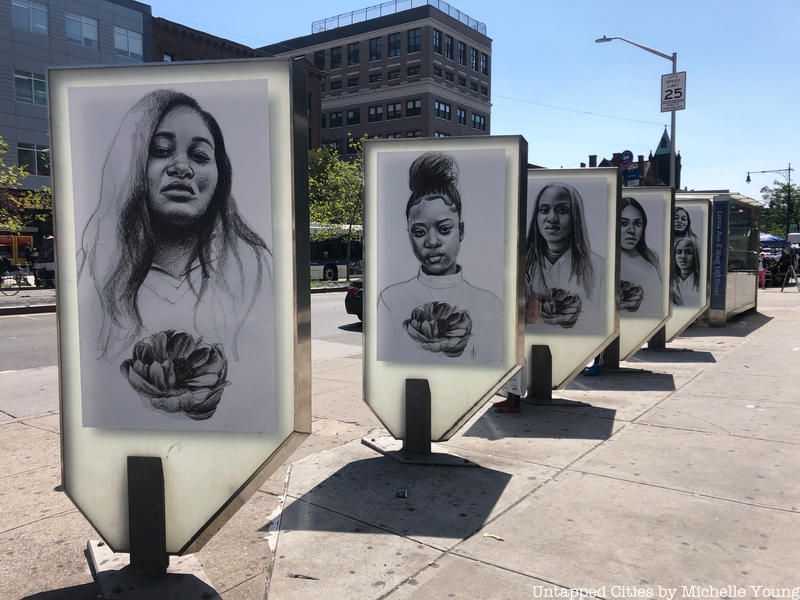
A series of display cases on Lenox Avenue and 125th Street in Harlem contain an exhibition by Brooklyn artist Tatyana Fazlalizadeh, a Black/Iranian visual artist who is the New York City Commission on Human Rights’ Public Artist in Residence. The series, Stop Telling Women to Smile, is a continuation of a movement started by the artist in 2012 that can be found on walls all across the world. Her artist residency here in New York City aims to “present the experiences of anti-black racism and sexual harassment experienced by New Yorkers through public art.”
Stop Telling Women to Smile showcases portraits of women on each display case, with captions on the back that speak directly to street harassment offenders. One of the cases shows actual written responses on postcards Fazlalizadeh placed in locations around the city, with questions like “What assumptions to people make about you because you are black?” and “What do you want to say back to your harassers on the street?” As Fazlalizadeh writes on the website about the project, “Street harassment is a serious issue that affects women world wide.
This project takes women’s voices, and faces, and puts them in the street – creating a bold presence for women in an environment where they are so often made to feel uncomfortable and unsafe.” The work will be up until at least August 2020. Fazlalizadeh also has another exhibition, Respecting Black Women and Girls in St. Albans, in Queens at the Daniel M. O’Connell Playground.
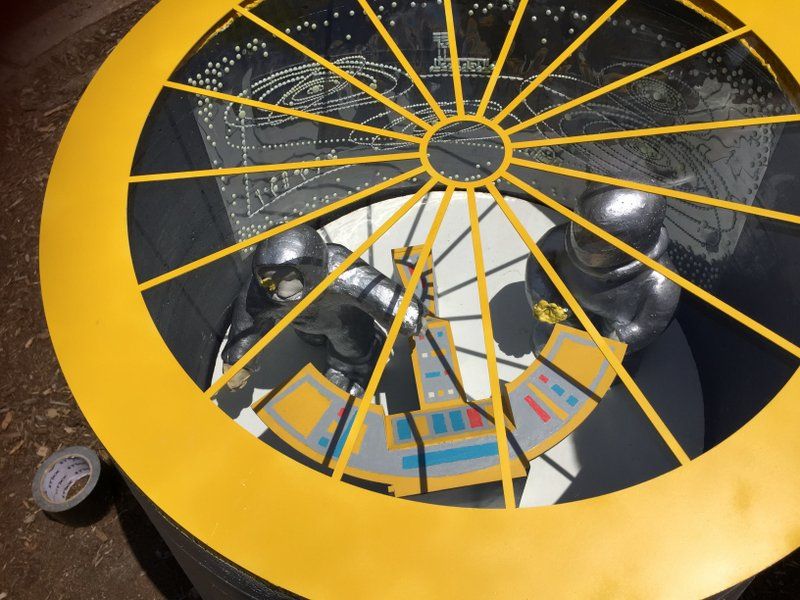
Photo courtesy NYC Parks
A new public art installation by Queens-based artist Yvonne Shortt, has just been unveiled in Flushing Meadows-Corona Park. Shortt’s immersive installation, titled Pavilion Landing, is clearly inspired by shape of the iconic New York State Pavilion (aka Tent of Tomorrow), which was painted in “American Cheese Yellow” color in 2015 as part of a restoration effort. Created in response to the theme “Flushing Meadows Corona Park: A Park for the Future,” it tells the story of intergalactic children whose spaceship has landed in the park. The artist worked with park visitors to create sculptures of children out of clay, which she then cast in concrete.
Funded by the Alliance for Flushing Meadows Corona Park in collaboration with NYC Park’s Art in the Parks program, Pavilion Landing is part of an effort to bring contemporary public artworks to the city’s parks. The goal of the program, as announced by NYC Parks Commissioner Mitchell J. Silver, is to “promote the less frequented core of our parks and support local artists.” Pavilion Landing can be found at the 111th Street and 49th Avenue Park entrance, located on the lawn alongside David Dinkins Circle. It will be on display until June 2020.
Visit this installation while on either our next tour of the Remnants of the World’s Fairs or on an Untapped Insiders special visit inside the Queens Museum with the new President of the museum.

Simone Leigh, Brick House, 2019. A High Line Plinth commission. On view June 2019 – September 2020. Photo by Timothy Schenck. Courtesy the High Line
For about two months, Simone Leigh’s Brick House has been admired from afar as it loomed over 10th avenue. This month, visitors can get an up close look at the giant sculpture when the Spur, the newest section of the High Line opened on June 5th. It is the first sculpture to be displayed in the new space, which will host a series of rotating exhibits.
Brick House, a sixteen-foot-tall bronze bust of a black woman. Her head is adorned with an afro and cornrow braids along her hairline. The figure sits atop the Plinth, a new exhibition space at on the plaza of the Spur. Brick House is the first work in the series Anatomy of Architecture by Simone Leigh. The series of sculptures will intermingle architectural forms from West Africa to the American South with the human body. Brick House will be up until September 2020.

A new sculpture in Duarte Square Park commemorates one of the most intense natural disasters New York City has faced. Inspired by the destruction of Superstorm Sandy, Robert Lobe’s sculpture takes the shape of the storm’s wreckage. Superstorm is made up of hammered metal in the shape of a tree and boulder that were blown apart during the storm. The form was captured by actually taking a cast of the tree and boulder in the forest.
The tree once stood in the forest along the Appalachian Trail in Northwest New Jersey at Harmony Ridge Farm and Campground. During the storm, the tree was blown over and Lobe said “it had become a majestic horizontal sculpture with a flat circular root pattern spiraling vertically into the air, evidence of the shallow yin and yang sloping surface of its former boulder home.” The art piece shows “the unfriendly side of nature” and how superstorms are becoming a more intense and frequent problem as our climate changes. Superstorm can be found at the intersection of Avenue of the Americas and Canal Street until June, 2020.
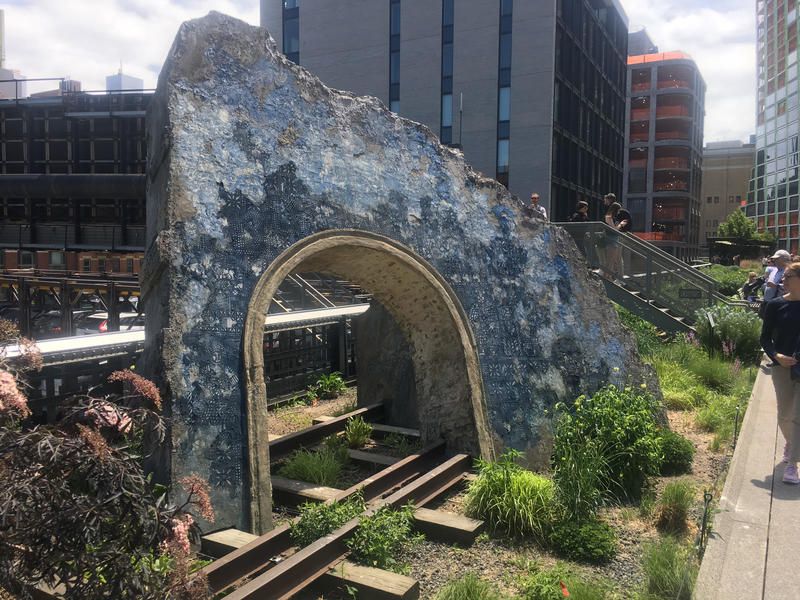
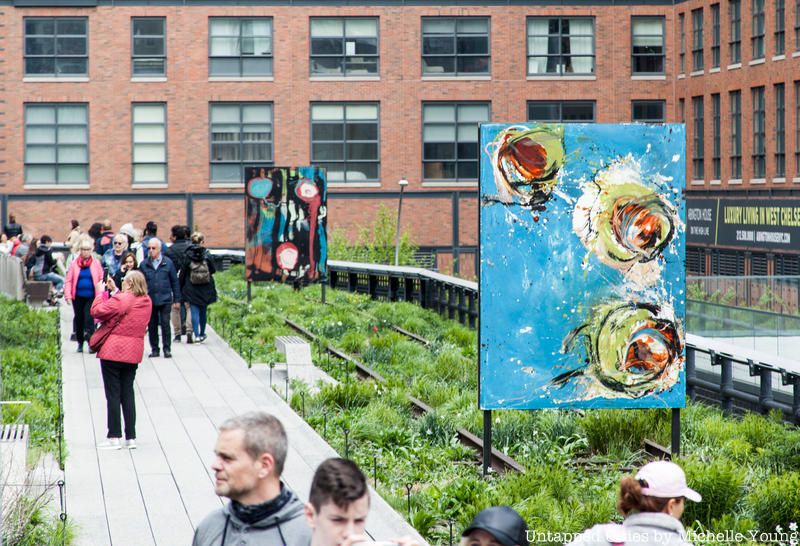

“En plein air” refers to the 19th century practice of painting outdoors, something inspired by, and a reaction to, the extreme changes happening in urban areas during the Industrial Revolution. The High Line, being a remnant of New York City’s industrial era, is the perfect place to reexamine and re-explore the tradition of outdoor painting, and with the involvement of several international artists, En Plein Air is an annual installation that challenges conventional sculptures and murals with freestanding, outdoor paintings that explore and restructure the relationship between art, nature and the modern urban city.
The first work above at 20th Street is by Firelei Báez, she depicts a Haitian Sans-Souci Palace ruin that looks like it is collapsing into the High Line. As High Line Arts describes, “In this ongoing body of work, Báez examines incarnations of Sanssouci: the 18th century Rococo palace built by Frederick the Great, the palace of Haitian Revolution leader and proclaimed first King of Haiti Henri Christophe, and Haitian revolution leader Jean-Baptiste Sans Souci, who was assassinated by Henri Christophe.” The second work, a series of four resign paintings, above is by Ryan Sullivan, embedded into the rail lines and plantings at 29th Street.
At 26th Street. Japanese artist Ei Arakawa has created two LED light paintings of fish, an interpretation of French painter Gustave Courbet’s 1872 and 1873 paintings, both titled La truite (The Trout). Other works include hundreds of striped flags at the Western Rail Yards by French artist Daniel Buren (known for his columns at the Palais Royal in Paris), ceramic archways by American artist Sam Falls embedded with fossilized plants from the High Line, life-size portraits on reclaimed doors from Georgian townhouses by Tanzanian artist Lubaina Himid, a large-scale sculpture at The Spur by Lara Schnitger, and a series of unstretched canvases inspired by an artist Vivian Suter Argentian home greet visitors at the southern edge of the park.
En Plein Air will be on display at several locations on the High Line until March 30, 2020.
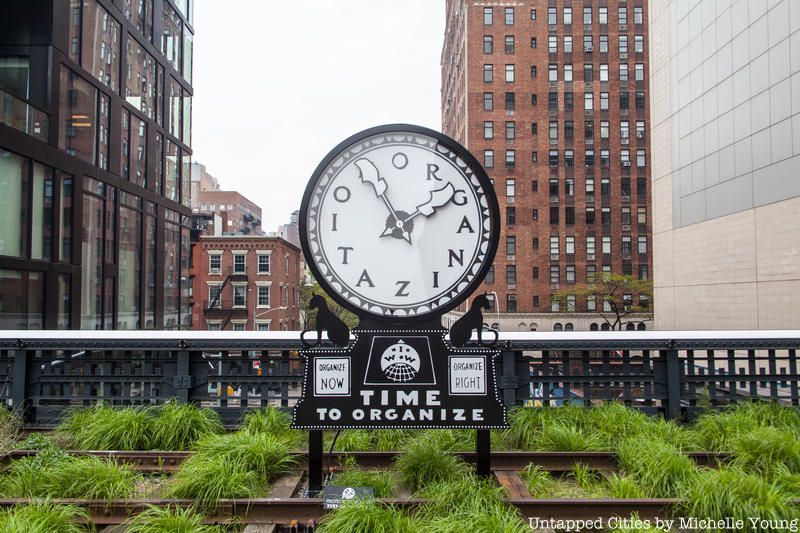
Ruth Ewan’s large-scale, double-sided clock, visible from the street, is based on the Industrial Workers of the World (IWW) labor union’s illustrations; the clock was once one of the many images used on “stickerettes,” otherwise known as “silent gators,” and distributed by union members as they travelled from job to job. The clock was an homage to the round-the-clock work of the union, as well as a callout to factory owners and how they divided public and private time. Ruth Ewan’s work now serves as a call to action for today’s labor struggles and the fight for diminishing labor rights, including the five-day work week and eight-hour work day.
Ruth Ewan’s Silent Agitator is the artist’s first public installation in the United States and will be on display on the High Line Park at 24th Street from April 3, 2019 to March 31, 2020.

In Battery City Park at the Museum of Jewish Heritage, an actual artifact from the early twentieth century is now on display. This freight car is not a replica and was actually used by the German National Railway during World War II to transport soldiers, prisoners of war, and then Jews to killing centers.
The freight car is an element of the upcoming exhibition Auschwitz. Not long ago. Not far away. will be on view until August 30, 2020 and includes over 700 artifacts from World War II never before seen in the United States.
 Photo courtesy of Yvonne Shortt
Photo courtesy of Yvonne Shortt
Rabbits are invading MacDonald Park in Forest Hills, Queens. Forest Hills resident and artist Artist Yvonne Shortt worked with her studio team and students from York College, Queens College, International High School of Health Sciences, and Academy of American Studies to cast and paint clay sculpted bunnies for her new installation Rigged?. The installation is a maze with stairs and windows that the bunnies are trying to navigate to get to the bunch of carrots on the top level.
A sign on each level leads to the next staircase, until the level just before the top. It is impossible to complete the maze. In a secret entrance at the bottom of the piece, one rabbit hoards a stash of carrots. The rabbit maze is a commentary on the social, economic, and political system. It will be on display from July 10th, 2019 through July, 2020.

A series of four recycled steel sculptures by Brooklyn-based artist Fitzhugh Karol are located at Front Street at York Street, in front of Bridge Street on the corner of Prospect and Jay Streets, Clumber Corner, and Bar and Grill Park. All four pieces come from one large structure, and as the DUMBO BID describes, Karol’s “process of creation in the studio involves playing with parts and shapes to create visually poetic combinations.” Previously Karol’s work has been seen in Prospect Park and Tappen Park on Staten Island. These sculptures will be on view through April 2020.
Next, check out our upcoming tours to explore more of New York City!
Subscribe to our newsletter